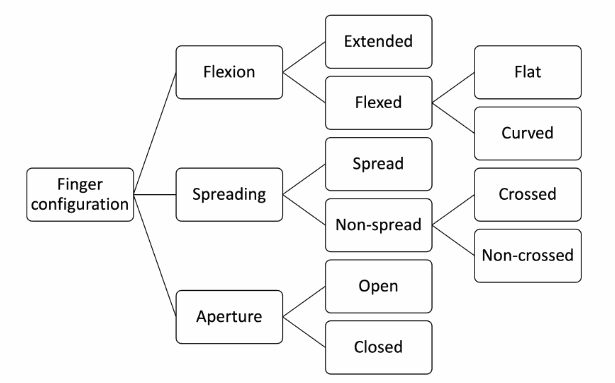1.1.1.2. Finger configuration
The configuration or position of the active fingers of the hand (selected fingers) must be specified. The selected fingers are described based on one of these three properties (see Mandel [1981] and van der Kooij [2002]):
- Flexion.
- Separation between them.
- Opening in relation to the thumb.
Regarding flexion, the selected fingers can be extended or flexed. Flexion can occur at the metacarpophalangeal joint (flat configuration) or at the interphalangeal (and metacarpophalangeal) joints (curved configuration). In LSE, SAY is articulated with the index finger extended and WARN with the index finger flexed (curved).
Regarding spreading, the selected fingers can be spread or non-spread. If they are non-spread, there are also configurations where the fingers cross. SCHOOL is articulated with the index, middle, ring, and little fingers together, while in JEALOUSY they are separated.
The aperture indicates the position of the fingers in relation to the thumb: open when the fingers do not touch the thumb, and closed when the fingers touch the thumb. In CHURCH, the position of the fingers in relation to the thumb is open because the fingers do not make contact with the thumb of the same hand. On the other hand, in COINCIDE, the position is closed because the fingers touch the thumb.
The following diagram presents the three properties specified in finger configuration:

The table that we provide by clicking here presents the distinctive or contrastive handshapes following the previous classification. Each row of the table includes one of the specified handshapes from the previous section on "selected fingers".
The finger configurations can contrast with each other, as can be seen in the following examples of minimal pairs:
Next, an example of signs for each handshape from the previous table is presented clicking here.
Villameriel García, S. (2023). Phonology: sublexical structure: active articulators: phonemic handshapes: finger configuration. In S. Villameriel García (Ed.), Gramática de la Lengua de Signos Española (GramLSE) / Grammar of Spanish Sign Language (GramLSE). Real Patronato sobre Discapacidad-Centro de Normalización Lingüística de la Lengua de Signos Española. Retrieved Month DD, YYYY, from https://cnlse.es/es/recursos/gramlse/ingles/index/phonology/sublexical-structure/active-articulators/phonemic-handshapes/finger-configuration
- Back to index
- References
- Spanish sign language and written Spanish version
- Videoglossary (in Spanish Sign sign language and written Spanish)




